Do you have a question about the MELAG Vacuklav 30-B and is the answer not in the manual?
Diagram illustrating the external components of the MELAG Vacuklav® 30-B autoclave.
Overview of the control panel, including buttons, display, and status indicators.
Key specifications such as chamber size, power supply, pressure, temperature, and load capacity.
Details on features like fractionating pulsed vacuum, separate steam generation, and electronic parameter control.
Guidelines for placement, stability, power, water, and ventilation connections.
Instructions on how to safely remove the autoclave from its packaging.
Procedure to ensure proper condensate drainage by adjusting the autoclave's tilt.
Requirements for electrical connection, including voltage, current, and circuit protection.
Connecting the cooling water supply to the autoclave's inlet.
Connecting the cooling water outflow to a suitable drainage system.
How to connect the purified water supply from a storage container.
Guidance on connecting the autoclave to a water purification unit.
Steps for connecting and setting up an external printer for documentation.
Procedure to check the autoclave for leaks using the vacuum test function.
Performing a test run to verify autoclave operation under realistic conditions.
Importance of an installation record for warranty claims.
Essential safety precautions during initial operation and setup.
Checking power, cooling water, and purified feed water availability before starting.
Guidance on properly loading trays, containers, and items for effective sterilization.
Procedure for correctly closing the autoclave door.
How to choose the appropriate sterilization program based on load and packaging.
Steps to initiate a selected sterilization program after checks are complete.
Understanding the different phases and display messages during a program run.
Explanation of the information contained in the program print-out.
Precautions to take when removing hot items from the autoclave.
Guidelines for storing sterilized items to maintain sterility.
Information on reloading the autoclave and operational pauses.
How to stop sterilization or drying phases, including warnings and consequences.
How to respond to system warnings and error notifications.
Recommendations for handling breaks in operation to preserve the door seal.
How to display water quality and chamber temperature readings.
Option to extend the drying time for better results.
How the autoclave stores and manages records of sterilization cycles, including printing and data transfer.
How to adjust the autoclave's internal clock and calendar settings.
Function to heat the chamber before programs or maintain temperature between cycles.
How to view the total number of sterilization loads performed.
Information on standard options and when to consult experts for modifications.
General advice on troubleshooting and contacting support for malfunctions.
Troubleshooting steps for issues like no display, excessive water consumption, or poor drying.
Interpretation and remedies for various warning messages displayed by the autoclave.
Explanation of error codes, their causes, and recommended actions.
Guidelines for cleaning and preparing instruments before sterilization.
Understanding and preventing rust contamination from external sources.
Procedures for cleaning and maintaining the autoclave's components like the chamber and door seal.
Methods for monitoring autoclave performance and performing periodic tests.
Diagrams and descriptions of different autoclave installation configurations.
Detailed specifications including capacity, weight, electrical supply, and operational parameters.
Tips and methods to optimize drying results for sterilized items.
Diagram illustrating the external components of the MELAG Vacuklav® 30-B autoclave.
Overview of the control panel, including buttons, display, and status indicators.
Key specifications such as chamber size, power supply, pressure, temperature, and load capacity.
Details on features like fractionating pulsed vacuum, separate steam generation, and electronic parameter control.
Guidelines for placement, stability, power, water, and ventilation connections.
Instructions on how to safely remove the autoclave from its packaging.
Procedure to ensure proper condensate drainage by adjusting the autoclave's tilt.
Requirements for electrical connection, including voltage, current, and circuit protection.
Connecting the cooling water supply to the autoclave's inlet.
Connecting the cooling water outflow to a suitable drainage system.
How to connect the purified water supply from a storage container.
Guidance on connecting the autoclave to a water purification unit.
Steps for connecting and setting up an external printer for documentation.
Procedure to check the autoclave for leaks using the vacuum test function.
Performing a test run to verify autoclave operation under realistic conditions.
Importance of an installation record for warranty claims.
Essential safety precautions during initial operation and setup.
Checking power, cooling water, and purified feed water availability before starting.
Guidance on properly loading trays, containers, and items for effective sterilization.
Procedure for correctly closing the autoclave door.
How to choose the appropriate sterilization program based on load and packaging.
Steps to initiate a selected sterilization program after checks are complete.
Understanding the different phases and display messages during a program run.
Explanation of the information contained in the program print-out.
Precautions to take when removing hot items from the autoclave.
Guidelines for storing sterilized items to maintain sterility.
Information on reloading the autoclave and operational pauses.
How to stop sterilization or drying phases, including warnings and consequences.
How to respond to system warnings and error notifications.
Recommendations for handling breaks in operation to preserve the door seal.
How to display water quality and chamber temperature readings.
Option to extend the drying time for better results.
How the autoclave stores and manages records of sterilization cycles, including printing and data transfer.
How to adjust the autoclave's internal clock and calendar settings.
Function to heat the chamber before programs or maintain temperature between cycles.
How to view the total number of sterilization loads performed.
Information on standard options and when to consult experts for modifications.
General advice on troubleshooting and contacting support for malfunctions.
Troubleshooting steps for issues like no display, excessive water consumption, or poor drying.
Interpretation and remedies for various warning messages displayed by the autoclave.
Explanation of error codes, their causes, and recommended actions.
Guidelines for cleaning and preparing instruments before sterilization.
Understanding and preventing rust contamination from external sources.
Procedures for cleaning and maintaining the autoclave's components like the chamber and door seal.
Methods for monitoring autoclave performance and performing periodic tests.
Diagrams and descriptions of different autoclave installation configurations.
Detailed specifications including capacity, weight, electrical supply, and operational parameters.
Tips and methods to optimize drying results for sterilized items.
| Type | Steam sterilizer |
|---|---|
| Drying Function | Yes |
| Cooling Function | Yes |
| Sterilization Temperature | 134°C |
| Power Supply | 230 V / 50 Hz |
| Display | Digital display |
| Material | Stainless steel chamber |
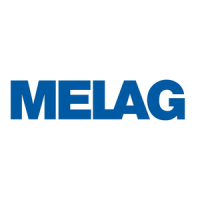
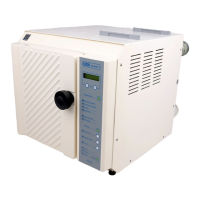
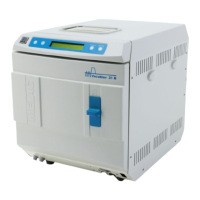
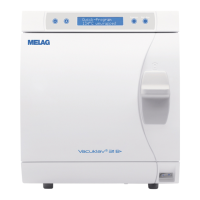
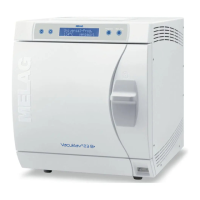
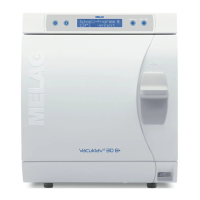
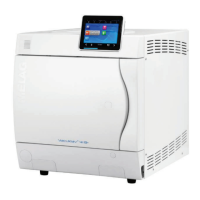
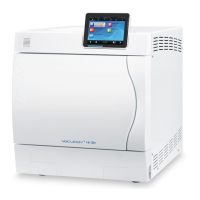


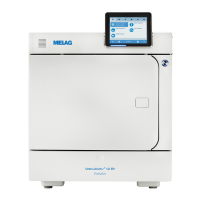
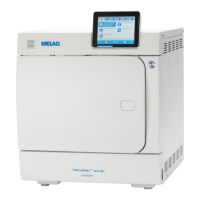
